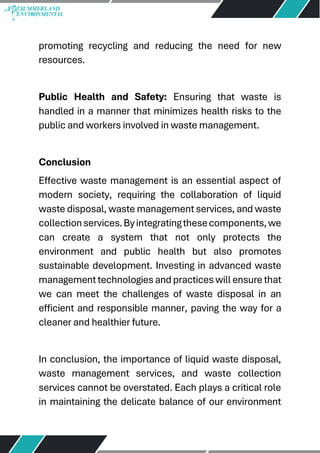The Best Guide To Reclaim Waste
Table of ContentsIndicators on Reclaim Waste You Should KnowReclaim Waste - QuestionsA Biased View of Reclaim WasteThe smart Trick of Reclaim Waste That Nobody is Talking AboutExcitement About Reclaim Waste
Check out the types, occurrences, and forms of fluid waste. Domestic sewage waste describes the waste and products from a household septic system. This kind of waste is produced by human beings in residences, institutions, and other buildings. This only includes septic tanks that have a drainpipe field. The proper administration and disposal of domestic sewage waste require fluid waste to be transferred to a sewer therapy plant where the proper approaches and equipment are used to purify and deal with waste.
Commercial waste often consists of prospective threats, such as combustible products or a blend of fluid and solid waste items, and calls for a much more advanced and in-depth disposal process. The disposal of commercial waste normally entails the purification of waste before transportation to make sure secure and appropriate disposal. Hazardous waste is developed from byproducts and runoff of industrial procedures and manufacturing.
This type of waste can not make use of the same sewage monitoring transport or procedures as septic or commercial liquids. The commercial waste administration procedure calls for the assessment and testing of liquid waste before it undergoes the disposal procedure (liquid waste removal). Runoff waste is the fluid waste that originates from overflow and excess stormwater in highly populated locations or cities
Drainage waste can cause contamination and flooding if not managed appropriately. Ensuring appropriate waste administration can prevent calamities and decrease ecological injury.
The 8-Minute Rule for Reclaim Waste
Contact PROS Providers today to learn more about our waste administration and disposal services and the correct means to care for the liquid waste you create.
(https://businesslistingplus.com/profile/reclaimwaste1/)This supposed 'wastewater' is not just a vital resource but, after therapy, will certainly be released to our land, waterways or the sea. Made use of water from bathrooms, showers, bathrooms, kitchen sinks, laundries and commercial processes is known as wastewater.

water used to cool equipment or clean plant and tools). Stormwater, a type of wastewater, is overflow that streams from agricultural and city areas such as roofings, parks, gardens, roadways, paths and gutters into stormwater drains, after rainfall. Stormwater hop over to these guys streams unattended directly to local creeks or rivers, ultimately getting to the sea.
Get This Report about Reclaim Waste
In Queensland, most wastewater is treated at sewage treatment plants. Wastewater is delivered from domestic or commercial sites through a system of sewers and pump stations, called sewerage reticulation, to a sewer treatment plant. City governments build, maintain and operate most sewage therapy plants. Operators are certified under the Environmental Management Act 1994 to discharge treated wastewater at an acceptable environmental standard into rivers.
The Department of Natural Resources recommends city governments regarding managing, operating and keeping sewage systems and therapy plants. In unsewered locations, neighborhood governments may need owners to set up individual or household sewer therapy systems to deal with residential wastewater from commodes, kitchens, bathrooms and washings. The Division of Natural Resources authorises making use of household systems when they are shown to be efficient.
The majority of stormwater receives no treatment. In some new communities, therapy of some stormwater to remove trash, sand and crushed rock has begun making use of gross pollutant traps. Wastewater treatment happens in 4 stages: Eliminates solid issue. Larger solids, such as plastics and other items wrongly discharged to drains, are gotten rid of when wastewater is gone through screens.
Wastewater after that streams right into big storage tanks where solids clear up and are removed as sludge. Grease and residue are skimmed from the surface. Utilizes little living microorganisms referred to as micro-organisms to damage down and get rid of continuing to be dissolved wastes and great bits. Micro-organisms and wastes are integrated in the sludge. Removes nitrogen and phosphorus nutrients that can trigger algal blooms in our rivers and endanger water life.
Reclaim Waste Things To Know Before You Buy
Nutrient elimination is not offered in any way sewage therapy plants because it needs expensive specialized tools. It is coming to be a lot more usual in Queensland. Clear fluid effluent created after therapy may still include disease-causing micro-organisms. If this effluent is released right into rivers such as rivers or the sea, the micro-organisms will ultimately pass away out.

This generally indicates wastewater has to be treated or impurities removed before it can be discharged to waterways. Many wastewater moves into the sewerage system. Under the Act, local governments carry out authorizations and licences for environmentally relevant tasks (Ages) entailing wastewater releases that may have a regional influence. The division carries out authorizations and licences to Periods entailing wastewater launches that could have a regional or statewide influence.
Things about Reclaim Waste
Surveillance provides valid info concerning water high quality and can validate that permit conditions are being met. The info obtained through surveillance supplies the basis for making water quality choices.